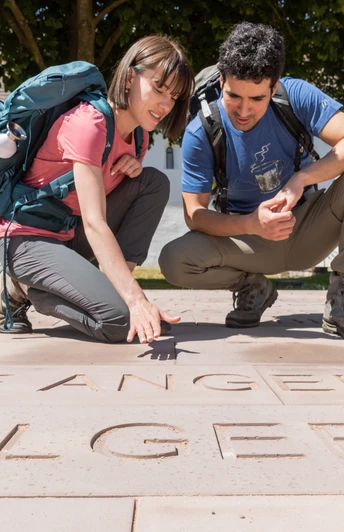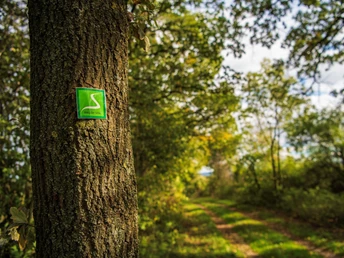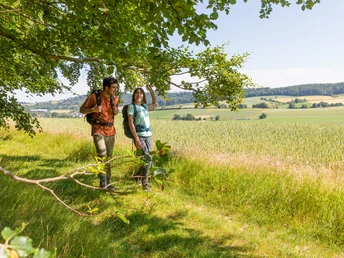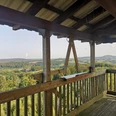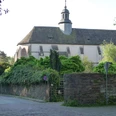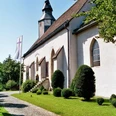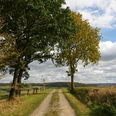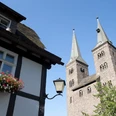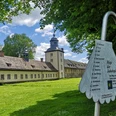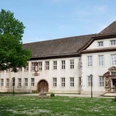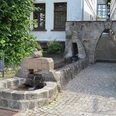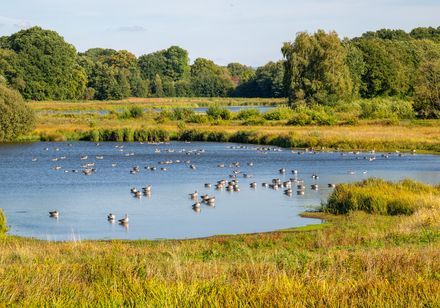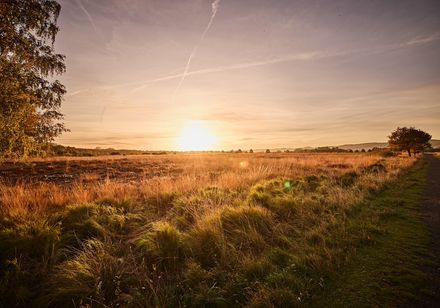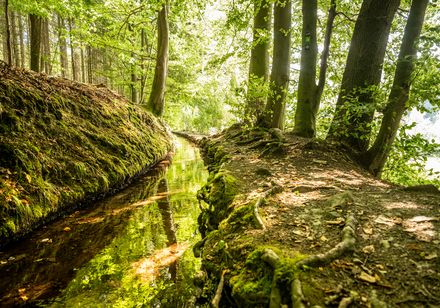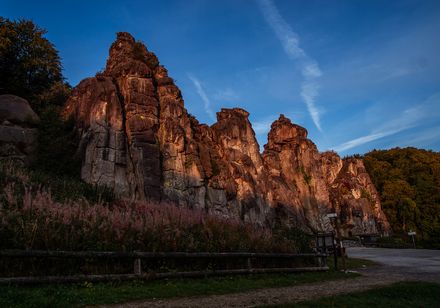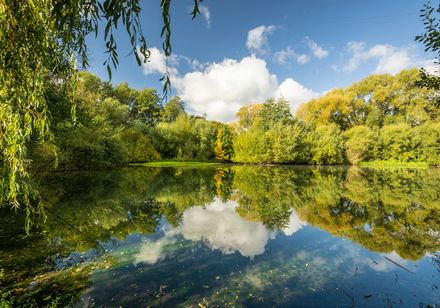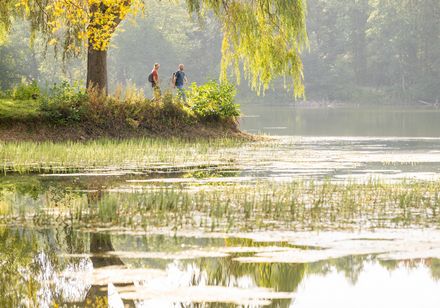- 11:57 h
- 42.33 km
- 777 m
- 927 m
- 94 m
- 331 m
- 237 m
- Start: Marktstraße, 32816 Schwalenberg
- Destination: Corvey, 37671 Höxter
The starting point of the ecumenical pilgrimage route is the historic town center of Schwalenberg, above which the castle of the same name towers, visible from afar. But the winding alleyways and the many richly decorated half-timbered houses also characterize the appearance of the small town.
The trail first takes you on a loop along the Schwalenberger Stadtwasser. Not only can you listen to the gentle lapping of the water, but it is also worth taking a closer look: The topography of the castle hill and the slight gradient of the stream create the optical illusion that the water in Schwalenberg is flowing uphill.
Before you continue on your way, you can pay a visit to the Evangelical Reformed Church of Schwalenberg. Inside the church, the Emmaus panel painting in the choir is worth seeing. It shows the resurrected Christ with the two disciples on the road to Emmaus and is therefore the perfect introduction to the pilgrimage route - it is not just about the distance covered, but also about an inner journey.
Through the Schwalenberg forest, which has been thinned out in some places by the bark beetle and opens up completely new views, the path leads you down to the Steinbach stream, which is crossed over a few stepping stones. At the Westerberg (just before Kollerbeck), you will have a wonderful panoramic view of the wide landscape. The ideal opportunity to take a short break, enjoy the view and listen to the silence. Continue along the Burgensteig trail, past the striking Oldenburg, to the former Benedictine Abbey of Marienmünster. The baroque monastery complex has made a name for itself as a "monastery of sounds": not only are top-class classical music recordings produced here, but numerous concerts and musical events are also held. Perhaps you are lucky enough to be able to listen to the sounds of the historic Johann Patroclus Möller organ in the abbey church (now a Catholic parish church) during your visit. This holds the sound memory of Westphalia and is known far beyond the region.
The second stage takes you from Marienmünster Abbey to the Hungerberg. "Once you have made it up this difficult and steep path, you are satisfied and feel the peace and freedom. At this point, you are particularly close to heaven, you can take a deep breath," promises a meditation station next to the Hungerberg Chapel. And indeed, if you climb the observation tower, the sky is close enough to touch and the view extends as far as the Hermann monument, across the Steinheim basin to the Ottenstein plateau and the Köterberg.
Once back down, the trail leads through a beautiful avenue, past the Jewish cemetery and through the climatic health resort of Vörden. You can take another break at the pilgrim crosses between Vörden and Eilversen or at the rest area in Eilversen itself and fortify yourself for the rest of the route.
The route then continues above the village of Bremerberg and through the Heiligengeisterholz forest area. You follow wide forest paths as well as narrow forest trails and can enjoy beautiful views time and again. In this section, you follow the historic monastery trail and can catch a glimpse of the Brenkhausen Monastery and the village of the same name a few kilometers before the end of the second stage.
The Brenkhausen Monastery is now home to the headquarters of the General Bishop of the Coptic Orthodox Church in Germany. In the spirit of living ecumenism and hand in hand with the Catholic parish, they are allowing monastic life to flourish anew. You are cordially invited to immerse yourself in this world for a moment and hear about the spirituality of the Coptic Church.
The 3rd stage leads from Brenkhausen up to the Räuschenberg nature reserve. From up here, you have a wonderful view of Brenkhausen and the Weser Uplands. The sunny slopes of the Räuschenberg are traditionally grazed by goats. While in spring you can marvel at the colorful flowers, in summer oregano and thyme provide a Mediterranean flair with their aromatic scent.
Past the small airfield on the Räuschenberg and through a wooded area, you are now getting closer and closer to the town of Höxter. As you get closer to the town, the sounds of everyday life will once again dominate your perception. Perhaps this is an opportunity to consciously listen and get an idea of how the surrounding sounds frame your own world.
The pilgrimage trail now leads right through the half-timbered town of Höxter. The two towers of the Kiliani church can be seen from afar. The curious thing is that the two towers are not only different heights, but also have two owners. While the smaller tower is maintained by the city, the taller tower is the responsibility of the Protestant parish.
Passing the historic town hall, you then come to the banks of the Weser, which you now follow to Corvey. Simple, imposing and fortified on the outside. Inside, sublime, majestic and dignified. This is the appearance of the westwork of Corvey, which is unparalleled in Europe with its more than 1,200 years of history. In June 2014, it was added to the UNESCO World Heritage List together with the old monastery district. In addition to the Carolingian westwork, the baroque palace complex, the cloister and abbots' gallery as well as the magnificent imperial hall are also worth seeing. The Princely Library, where the poet Hoffmann von Fallersleben once worked as a librarian, is home to almost 75,000 volumes.
If you have now acquired a taste for pilgrimage, you can follow the Way of St. James from Corvey towards Paderborn and on to Spain. Get on your way!
Good to know
Best to visit
Directions
Route markings
Tour information
Cultural Interesting
Labelling
Multiday Tour
Possibility of Accommodation
Stop at an Inn
Directions & Parking facilities
https://www.fahr-mit.de/fahr-mit/fahrplan-und-liniennetz/fahrplanauskunft-fm.php
Additional information
Contact person
License (master data)
Kulturland Kreis Höxter
Author´s Tip / Recommendation of the author
Our recommendations
